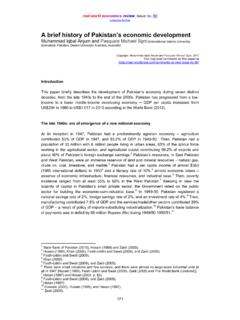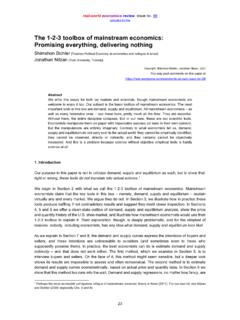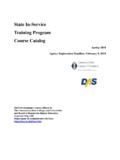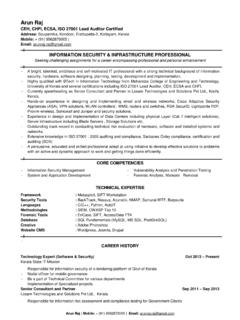Transcription of The financial sector and the real economy - …
1 real -world economics review, issue no. 57 The financial sector and the real economy Dietmar Peetz and Heribert Genreith (Institute for Applied Risk management , Germany) Copyright: Dietmar Peetz and Heribert Genreith, 2011 You may post comments on this paper at Abstract The uncertainty precipitated by the lingering fallout from the financial , economic, and debt crises increases daily. Meanwhile, leading mainstream economists are being criticized for their divided positions on the correct diagnosis of and viable solutions for these crises. Classical economic growth theories were unable to predict these dilemmas, as they did not adequately take into account factors such as the macroeconomic impact of outsized financial sector developments. Classical economic models are still considered by many economists to be the correct tools for dealing with the consequences of the 2008-2011 credit crisis ("crisis").
2 Meanwhile, others view crisis as stemming from the global imbalances precipitated by the application of these classic macro models. This contradiction seems irreconcilable. A new approach is therefore necessary. In this review, we present an alternative growth model. Specifically, one which helps to analyze the interdependence between the financial and the real economy and which also yields analytical statements about the causes of crises. Introduction Sufficient capital is the basic prerequisite for enabling economic processes. Innovation is impossible without the availability of adequate capital. Mainstream economic growth models assume that categorical positive relationship exists between the two. However, as the recent financial and economic crises revealed, there is a fundamental interaction between the financial sector and the gross domestic product (GDP) of an economy .
3 The relationship between the two is, however far away from being linear. This is demonstrated in chart 1 for Germany. In the case of Germany, financial assets - measured by total bank assets - grew significantly faster than the gross domestic product (see chart 1). Interestingly, a tendency for stagnating and (in 2009) even falling growth rates for GDP can be ascertained. Allow us a brief historic synopsis. At the end of the 80s there was a surge in GDP due to the integration of the East German economy . At the same time, nominal assets increased due to the conversion of Ost-Marks into Deutsch-Marks. Afterwards, GDP grew only linearly, while financial assets experienced massive exponential growth. As of the 90s, growth rates in the real economy fell by such a degree that capital could no longer earn the high returns of the past.
4 As a result, capital increasingly gravitated to the higher return potential of the financial markets (equities, private equities, hedge funds etc.). This caused the so-called "savings glut," a situation wherein too much capital is chasing too few investment opportunities. It is in this context that the term "financialization" is often used by economists. Financialization describes the process by which increasingly more corporate earnings and personal income result from financial transactions and not from real economic growth, , increased production and related growth in employment. 41real-world economics review, issue no. 57 Chart 1: Development of nominal gross domestic product and banking assets in billion Source: German Bundesbank, total assets of all German banks, time series OU0308, GDP data: Noteworthy in chart 1 is the onset of exponential growth in financial wealth after the collapse of the tech bubble in early 2000.
5 The financial and economic crises have also left their marks. Between 2008 and 2009, both GDP and financial asset valuations fell. Valuations fell from a peak of 8093 billion EUR in October 2008 to 7472 billion EUR at the end of October 2010. Due to unprecedented interventions by central banks and policy makers, a sharper decline has thus far been prevented. Central banks continue to attempt to kick start economic growth by expanding the money supply. Economic growth, as expounded by classical macro models (especially the IMF model of 20051) should have risen proportionally with monetary expansion. Unfortunately, empirical observations show that just the opposite happens when the debt to GDP ratio has already grown too large (as is currently 1 , pp 118, 121, and in addition page 105: The investment equation is less successful than the saving equation in tracking recent developments.)
6 This result is similar to other recent studies, which have found that traditional econometric models of investment have difficulty explaining recent trends. The equation over predicts investment in both the industrial and emerging market regions, in some cases by large margins. For instance, while the equation predicts that investment should have increased in industrial countries largely as a result of the decline in the cost of capital investment in several key industrial countries, including Japan and the Large Euro countries fell. Similarly, the equation fails to explain the drop in investment in emerging markets, particularly in the east Asian countries. The equation suggests that the investment accelerator whereby investment rates and output growth move in the same direction has not worked as strongly as expected in recent years in these countries, most likely because corporates have focused on reducing debt and strengthening balance sheets, rather than on investing in capital.
7 42real-world economics review, issue no. 57 the case in Greece, the US, and other countries). How can this conflict between theory and reality be resolved? A new macro-model Models display cause and effect principles. In this review, we endeavor to determine the relationship between GDP Y and financial assets K. We will revisit the increasingly contested relationship between these two functions. In so doing, we shall deploy the very mathematical modeling procedures which are well known in the natural sciences. For mathematical reasons we need at least two linearly independent equations to define the relationship. Our basic equation system has the following structure: )()()()()(0tKtptYtptbdtdYYB++= and )()()()()(0tKtptYtptadtdKKS++= with initial conditions Y(0) = Y0 and K(0) = K0. In the case of Germany, Y0 = Y (1950) and K0 = K (1950). This coupled system of differential equations describes the effect, , the growth rates of Y and K as autonomously generated data points.
8 Said data points stem a) from independent causes (a0, b0) and b) from the function (Y, K), which is itself causal. In this sense, the parameter functions have to be determined. These are in principle - as are the sought unknown functions Y and K - functions of time. The parameters a0 and b0 describe independent causes for the growth of GDP or capital. For example, a0 could represent the inflow or outflow of foreign capital (such as financial support from the IMF) and b0 could be an exogenous GDP inflow ( , grain donations from abroad). pn is what we call the net business investment rate of the banking industry and the function -pn, therefore, represents the net rate of investment in the real economy . pS denotes the savings rate, pB the population growth, pY the investment in the real economy , and pK the actual return on financial assets.
9 There is, however, a causal link between the parameters and the functions pY and pK. The interest/capital gains for financial assets ultimately have to be generated by the real economy (GDP). Therefore, our equation: pK = - pY: = pn (t). We distinguish between interest payments for financial assets and those for loans. Furthermore, we differentiate between capital that circulates in the financial system and the portion of capital which finds its way into loans for the real economy (either for consumption or investment purposes). The latter is called "net business rate" pn where pn = pv - pr (written in units of an interest rate). To determine the specific representation of the "net business investment rate pn we need information about investments in the real economy as well as information about "proprietary business investment," which the financial system processes within The share of loans going into the real economy 's total business ("prel") stood at 75% in 1950 ac- 2.
10 We interpret the financial systems as a subsystem of our social system. See Niklas Luhmann "Social Systems" (1996). 43real-world economics review, issue no. 57 cording to the Bundesbank (time series OU0115). Today, 60 years later, the figure has fallen to about 40%. Since we are interested in comparing " real economy loans" with overall asset growth (which represents the entire economy ), we express pr as a portion of interest payments or pv. The share of interest remaining after reinvestment in the real economy is given by: ))(21)(()()())(1)(()()()(tptptptptptptpt ptprelvrelvrelvrvn = = = We can interpret pn(t) as follows: because (accumulated) capital is growing faster than GDP, its relative capacity for making loans into the real economy declines. Assuming an exponential half-life (in this case Th = 80 years), prel can be phenomenologically stated as: )exp(1hhrelTTtep = This yields prel (0) = 1 = 100% and prel (80) = 1 / e = = 37% and prel ( ) = 0.








![for [ ] Independent Financial Advisors - MProfit](/cache/preview/2/1/2/b/1/f/3/f/thumb-212b1f3f7b283135c103240b12ea9770.jpg)


